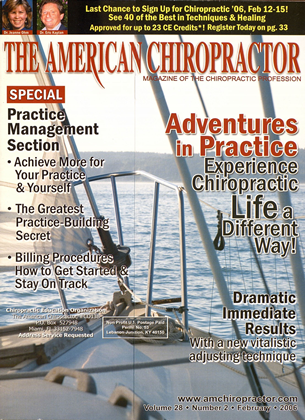Thousands of manual practitioners from around the world are finding surprising new ways of seeing and changing postural relationships via simple but effective Anatomy Trains Myofascial Meridian techniques—a holistic approach to myofascial balance. You may already know that soft-tissue work holds great promise for effective and long lasting care, but you also need a clear understanding of the Myofascial Meridian system, which unites the body and contributes to the proper alignment of the skeletal system it supports. Neuromuscular strain patterns communicate through the fascial webbing to pull the joints out of alignment and back into subluxation. Skilled myofascial work can quickly ease the strain and allow chiropractic adjustments the time to get settled. Thus, many doctors are getting more conversant with fascial and myofascial manipulation themselves, or hiring trained manual therapists who can apply this work effectively with their patients, especially those with long-term problems. Anatomy Trains presents a revolutionary new map of myofascial anatomy that bridges the gap between bony manipulation and massage-type approaches. Anatomy Trains is a sophisticated systems tool for identifying global strategies for soft-tissue problems, and treatment using the Anatomy Trains approach can lead to faster, longer-lasting results, including improved posture and physical functionality. In classical anatomy, muscles have been defined by what they would do if they were the only muscle on the skeleton, as shown in Figure 1. Or they are defined regionally, in the way they surround and support the bony complex. (See Figure 2) Of course, these are useful points-of-view; but the Anatomy Trains adds something different. It defines the longitudinal chains of muscles that connect through the parietal fascial webbing. Shortness or contractures within these complexes communicate along these myofascial lines to produce body-wide strain patterns in the patient's structure that need body-wide strategies to resolve. (See Figure 3) The connective tissue network begins as one organism-wide net in the first few weeks of development, and remains—from the scalp to the toes, from the meninges to the epidermis—a single net that distributes tensional strain around the body. The Anatomy Trains provides a map of those fascial pathways of strain. (See Figure 4) The Superficial Front Line (SFL), for instance, can be traced as a myofascial meridian from the top of the toes to the mas-toid process via the fascial connection running up the front of the legs and torso to the sternocleidomastoid and the astcrion. Shortness in this line often occurs in post-traumatic responses, or long-term psychological distress. Understanding these connections can show you or your soft-tissue ally how to make the manipulative work more permanent Anatomy Trains4 through soft-tissue support, sometimes from a place quite distant from the site of pain or subluxation. For instance, soft-tissue lengthening in the groin or costal arch can ameliorate the tendency to pull the neck forward after adjustment. (See Figure 5) Shortness in the Spiral Line (SL) often mediates rotations in the body, especially those due to occupational or recreational habits. This myofascial strain promotes rotational strain in the spine, either directly or through the rotatorcs' counter-reaction. The Superficial Back Line (SBL) runs from the bottom of the feet up along the primary and secondary curves of the spine, mediating the balance of the back of the body. (See Figure 6) Besides these lines, the system includes the Lateral Line running up each side, and the Functional Lines, which connect the contralateral girdles. In addition, there are four myofascial meridians running through the shoulders and arms from the axial trunk to the four comers of the hands. The core line, or Deep Front Line (DFL) runs from the inner arch up the inseam of the leg and on up the front of the spine. Working intelligently with this line can often be the complement that makes the difference between lasting change and temporary relief. (See Figure 7) The Anatomy Trains concept was developed from the ideas of Dr. Ida Rolf, with supporting neurological concepts from Dr. Moshe Feldenkrais, and geometry courtesy of architect Buckminstcr Fuller. Thousands of manual practitioners from around the world have found surprising new ways of seeing and changing postural relationships via the simple but effective techniques offered in the Anatomy Trains programs. (See Figure 8) Whatever approach you use to align the skeleton and ease the joints, persis- tent soft-tissue strain and neuromus-cular habit can sometimes stymie your best efforts. Myofascia creates and communicates strain. The Anatomy Trains systems approach makes sense of these myofascial strain patterns, rendering them visible and available for effective work. Understanding the Anatomy Trains material provides the missing link between your excellent chiropractic care and the patient's daily movement pattern. The information comprising Anatomy Trains is available in many forms, and the program is well-supported. The Anatomy Trains book (Elsevier 2001 -available on Amazon) comprehensively covers the system, with explanations of techniques, postural analysis, and movement applications. There are currently 10 Anatomy Trains DVD's that demonstrate many myofascial techniques and 3-D views of all the individual parts that make up each train. To learn more, get on board! Thomas Myers, Certified Advanced Rolfer*, LMT, NCTMB, is the founder and director of Kinesis. Inc., which offers courses internationally in integrated soft-tissue approaches, including Anatomy Trains supported by the Anatomy Trains DID. and DVD-ROM series. He trained directly with Dr. Ida Rolf. Dr. Moshe Feldenkrais. and Buckminster Fuller and has practiced iniegrative bodywork for more than 30 years. He can be reached by phone at 1-888-kinesis (546-3747), by email at infotwanatomytrains.net, or visit \\-\\~\\:AnatomyTrains.net. \
 View Full Issue
View Full Issue






